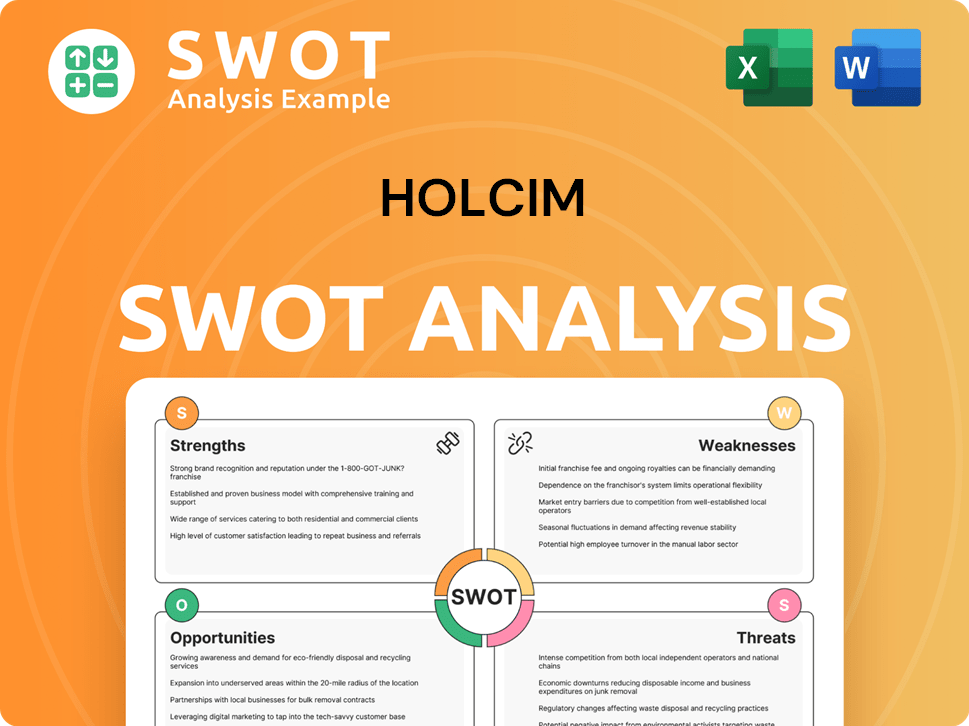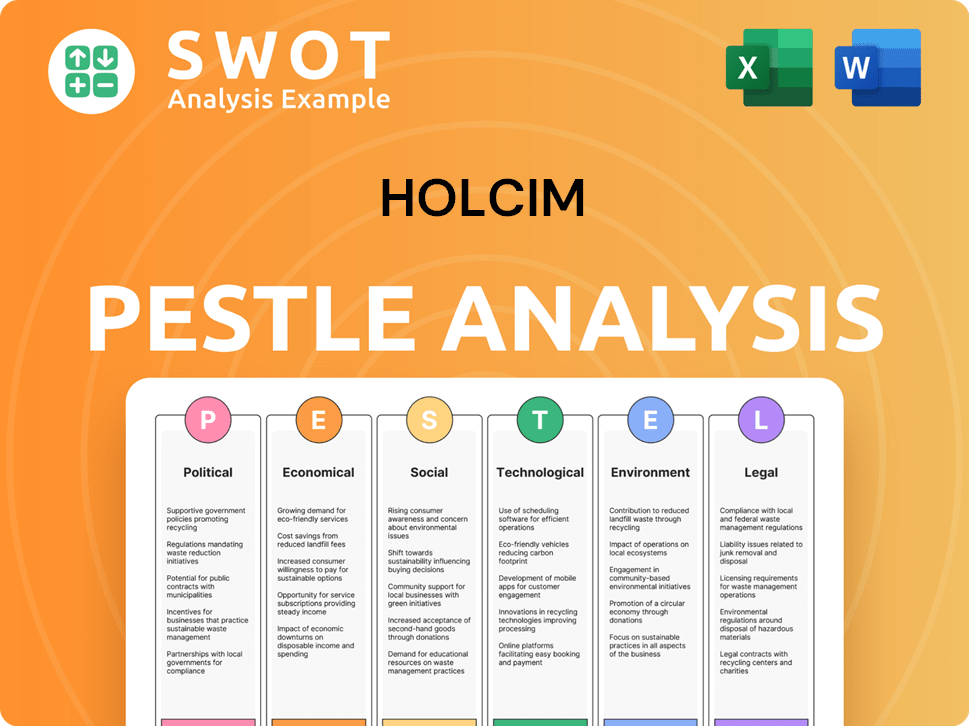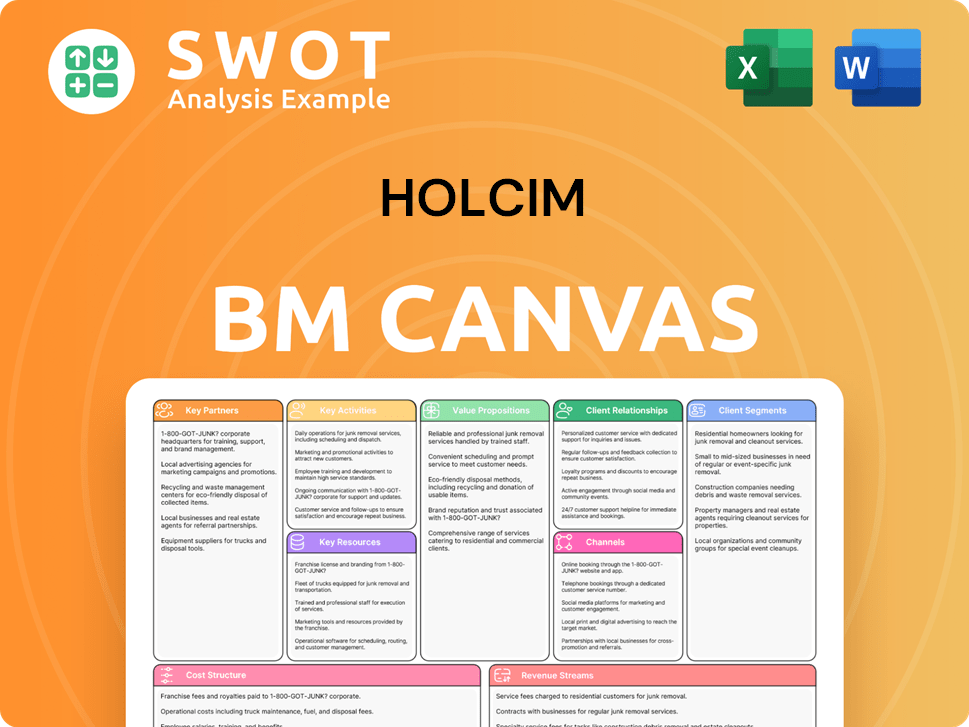Holcim Bundle
How did Holcim rise to become a global building materials giant?
Explore the captivating Holcim SWOT Analysis and uncover the remarkable journey of the Holcim company, a story that began in 1912 in Switzerland. From its humble roots as a cement manufacturer, Holcim has evolved into a global leader, shaping the world's infrastructure. This brief history delves into the key milestones and strategic decisions that propelled Holcim to the forefront of the cement industry.

Tracing the Holcim timeline reveals a century of growth, innovation, and strategic acquisitions. The Holcim Group's transformation from a regional player to a global powerhouse offers valuable insights into the dynamics of the cement industry. Understanding Holcim's early years and major acquisitions provides a crucial perspective on its present-day success and its impact on construction worldwide. This comprehensive overview explores the company's evolution.
What is the Holcim Founding Story?
The story of the Holcim company begins in the early 20th century, a period marked by significant industrial and infrastructural advancements. The Marketing Strategy of Holcim has evolved significantly since its inception, reflecting its growth and adaptation to changing market dynamics.
Holcim's history starts on February 15, 1912, with Adolf Gygi's establishment of 'Aargauische Portlandcementfabrik Holderbank-Wildegg' in Holderbank, Switzerland. This marked the genesis of what would become a global leader in the cement industry. The company's trajectory from its founding to its current status is a testament to its strategic vision and adaptability.
In 1914, the company merged with 'Rheintalischen Cementfabrik Rüthi,' under Ernst Schmidheiny's leadership, setting the stage for expansion. The initial focus was on producing and distributing cement, a crucial material for the burgeoning construction sector. This early focus laid the foundation for Holcim's future growth and influence in the cement industry.
Holcim's early years were defined by strategic mergers and a focus on cement production to meet the growing demand from industrialization and construction. The company's initial business model centered on cement production and distribution.
- Founded in 1912 by Adolf Gygi.
- Merged with 'Rheintalischen Cementfabrik Rüthi' in 1914, led by Ernst Schmidheiny.
- Focused on cement production to meet rising construction demands.
- Went public in 1958 to fund further expansion.
A key moment in Holcim's history was the name change in 2001, from 'Holderbank Financière Glaris' to Holcim. This rebranding, a portmanteau of 'Holderbank' and 'ciment,' signaled a modernized identity while honoring its heritage. The company's initial funding came from private investments, with a public offering in 1958 to support further expansion. The cultural and economic context of the early 20th century, with its increasing urbanization and infrastructure development, significantly shaped Holcim's early focus on essential building materials. The company's strategic decisions in its early years set the stage for its future global presence and influence within the cement industry.
Holcim SWOT Analysis
- Complete SWOT Breakdown
- Fully Customizable
- Editable in Excel & Word
- Professional Formatting
- Investor-Ready Format

What Drove the Early Growth of Holcim?
The early years of the Holcim company, formerly known as 'Holderbank,' were marked by significant growth and expansion. Following its establishment in 1912, the company quickly began to broaden its reach beyond Switzerland. This period set the stage for Holcim's transformation into a global leader in the cement industry. Learn more about the Target Market of Holcim.
In the 1920s, Holcim initiated its international expansion, starting with the acquisition of the Dutch Cement Company in 1923. This was swiftly followed by investments in Egypt, Lebanon, and South Africa. These early moves were crucial in establishing Holcim's global presence and diversifying its operations.
The post-World War II era, particularly the 1950s and 1960s, saw Holcim expand significantly in North and Latin America. A major milestone was the opening of a large cement production facility in Michigan, USA. The company went public in 1958 to fund this expansion, demonstrating its commitment to growth.
The 1970s marked Holcim's entry into the Asia-Pacific region. Leadership transitions, such as Hans Gygi and later Thomas Schmidheiny, played key roles in guiding the company's expansion. By 1986, 'Holderbank' had become the world's largest cement manufacturer, a testament to its strategic growth.
The 1990s saw a consolidation of European holdings and continued growth in the American market. Holcim also increased its focus on aggregates and ready-mixed concrete production, enhancing its position as a vertically integrated market leader. This strategic focus on emerging markets was key to its sustained growth.
Holcim PESTLE Analysis
- Covers All 6 PESTLE Categories
- No Research Needed – Save Hours of Work
- Built by Experts, Trusted by Consultants
- Instant Download, Ready to Use
- 100% Editable, Fully Customizable

What are the key Milestones in Holcim history?
The Holcim history is marked by significant milestones, strategic expansions, and a continuous evolution within the global cement industry. From its early years to its current status as a global leader, the Holcim company has consistently adapted to market changes and technological advancements.
| Year | Milestone |
|---|---|
| May 2001 | Rebranding from 'Holderbank Financière Glaris' to Holcim, signaling a new corporate identity. |
| 2005 | Expanded into the United Kingdom by acquiring Aggregate Industries for US$4.1 billion and into India through stakes in ACC and Ambuja Cement Eastern. |
| 2008 | Became the largest shareholder of China's Huaxin Cement with a 40% stake. |
| 2009 | Acquired Cemex Australia. |
| July 2015 | Merger with French rival Lafarge, forming LafargeHolcim, with a combined market value exceeding $50 billion. |
| May 2021 | Renamed back to Holcim, unifying its market brands. |
Innovation is a core aspect of the Holcim Group's strategy, particularly in developing sustainable building materials. The company focuses on reducing its environmental impact through various initiatives and product developments.
ECOPact green concrete is designed to reduce embodied carbon emissions by up to 100%, offering a significant step towards sustainable construction practices. This innovation allows for a substantial decrease in the environmental footprint of construction projects.
ECOPlanet cement incorporates recycled construction and demolition waste, contributing to a circular economy. This approach helps reduce waste and conserves natural resources.
Holcim is investing CHF 2 billion by 2030 in CCUS projects, aiming to capture over 5 million tons of CO2 annually. This investment underscores the company's commitment to reducing its carbon footprint and achieving net-zero emissions.
The company has a wide range of sustainable products, including green concrete and cement, designed to meet the growing demand for eco-friendly building materials. These products help in reducing the environmental impact of construction projects.
Holcim is using digitalization to optimize its operations and improve efficiency across its value chain. This includes the use of advanced technologies to enhance production processes and supply chain management.
Holcim is actively involved in circular economy initiatives, focusing on recycling construction and demolition waste and reducing overall waste generation. This approach supports resource efficiency and waste reduction.
The
The oil crisis of 1973 significantly impacted the construction industry, presenting a major challenge for Holcim. Economic fluctuations continue to pose risks to the company's financial performance.
As one of the top 50 carbon majors, responsible for 0.42% of global industrial CO2 emissions since 1750, Holcim faces scrutiny regarding its environmental impact. The company is actively working to reduce its carbon footprint.
Holcim has committed to becoming a net-zero company with 1.5°C targets validated by the Science Based Targets initiative (SBTi). This commitment drives the company's investments in sustainable technologies and practices.
The cement industry faces increasing regulatory scrutiny related to emissions and environmental impact. Holcim must continuously adapt to evolving regulations and compliance requirements.
The cement industry is highly competitive, with numerous players vying for market share. Holcim must continually innovate and improve its offerings to maintain a competitive edge.
Holcim operates globally, making it susceptible to geopolitical and economic risks in various regions. These risks can impact the company's supply chains, operations, and financial performance.
Holcim Business Model Canvas
- Complete 9-Block Business Model Canvas
- Effortlessly Communicate Your Business Strategy
- Investor-Ready BMC Format
- 100% Editable and Customizable
- Clear and Structured Layout

What is the Timeline of Key Events for Holcim?
The Holcim company has a rich history, marked by significant milestones that have shaped its global presence in the cement industry. From its humble beginnings in Switzerland to becoming a global leader, Holcim's journey reflects its adaptability and commitment to innovation. Key events, including strategic mergers and acquisitions, have propelled its growth and expanded its geographical footprint, solidifying its position in the construction sector.
| Year | Key Event |
|---|---|
| 1912 | Adolf Gygi established 'Aargauische Portlandcementfabrik Holderbank-Wildegg' in Switzerland. |
| 1914 | The company merged with Ernst Schmidheiny's 'Rheintalischen Cementfabrik Rüthi.' |
| 1922 | 'Holderbank' expanded internationally, entering the French market. |
| 1958 | The company went public to raise capital for further expansion. |
| 1970s | Expansion into Latin America and the Asia-Pacific region occurred. |
| 1986 | 'Holderbank' became the world's largest cement manufacturer. |
| 2001 | The company rebranded from 'Holderbank Financière Glaris' to Holcim. |
| 2005 | Acquired Aggregate Industries for US$4.1 billion, and invested in Indian cement companies. |
| 2014 | Holcim and Lafarge announced a US$60 billion 'merger of equals.' |
| 2015 | The merger with Lafarge was completed, forming LafargeHolcim. |
| 2021 | LafargeHolcim was renamed Holcim, and launched 'Strategy 2025 – Accelerating Green Growth.' |
| 2024 (Q1) | Reported net sales of CHF 5.586 billion. |
| 2025 (Expected) | Proposed spin-off of its North American business into Amrize. |
Holcim's 'Strategy 2025 – Accelerating Green Growth' focuses on accelerating growth, expanding solutions and products, and leading in sustainability. The company aims for a 3-5% net sales growth. The Solutions & Products business is targeted to reach 30% of Group sales.
Holcim is committed to ambitious sustainability targets, including recycling 75 million tons of materials and 10 million tons of construction and demolition waste by 2025. They are investing heavily in green capital expenditures, with a target of CHF 500 million. More than 40% of financing agreements are linked to sustainability goals.
Holcim plans to continue deploying smart technologies like 3D printing and developing next-generation technologies. This includes 30 pilot projects in carbon capture, utilization, and storage, with a target to operate at least one net-zero plant by 2030. The 2024 Climate Report highlights a 20% increase in recycled construction demolition materials.
The planned spin-off of the North American business as Amrize, expected by the end of the first half of 2025, is a strategic move. This will allow each entity to pursue tailored growth strategies. This forward-looking approach ties back to the founding vision by continuing to provide essential building materials while transforming the cement industry.
Holcim Porter's Five Forces Analysis
- Covers All 5 Competitive Forces in Detail
- Structured for Consultants, Students, and Founders
- 100% Editable in Microsoft Word & Excel
- Instant Digital Download – Use Immediately
- Compatible with Mac & PC – Fully Unlocked

Related Blogs
- What is Competitive Landscape of Holcim Company?
- What is Growth Strategy and Future Prospects of Holcim Company?
- How Does Holcim Company Work?
- What is Sales and Marketing Strategy of Holcim Company?
- What is Brief History of Holcim Company?
- Who Owns Holcim Company?
- What is Customer Demographics and Target Market of Holcim Company?
Disclaimer
All information, articles, and product details provided on this website are for general informational and educational purposes only. We do not claim any ownership over, nor do we intend to infringe upon, any trademarks, copyrights, logos, brand names, or other intellectual property mentioned or depicted on this site. Such intellectual property remains the property of its respective owners, and any references here are made solely for identification or informational purposes, without implying any affiliation, endorsement, or partnership.
We make no representations or warranties, express or implied, regarding the accuracy, completeness, or suitability of any content or products presented. Nothing on this website should be construed as legal, tax, investment, financial, medical, or other professional advice. In addition, no part of this site—including articles or product references—constitutes a solicitation, recommendation, endorsement, advertisement, or offer to buy or sell any securities, franchises, or other financial instruments, particularly in jurisdictions where such activity would be unlawful.
All content is of a general nature and may not address the specific circumstances of any individual or entity. It is not a substitute for professional advice or services. Any actions you take based on the information provided here are strictly at your own risk. You accept full responsibility for any decisions or outcomes arising from your use of this website and agree to release us from any liability in connection with your use of, or reliance upon, the content or products found herein.